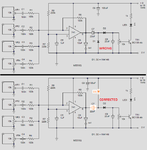rajaram04
Advanced Member level 3
Hello sir
here i got a link with a circuit diagram for a 4 channel audio mixer using 741
https://wrojh.blogspot.in/2011/02/4-channel-audio-mixer-using-op-amp-741.html

please check if it is ok or not . . should i implant it exactly ?
here i got a link with a circuit diagram for a 4 channel audio mixer using 741
https://wrojh.blogspot.in/2011/02/4-channel-audio-mixer-using-op-amp-741.html

please check if it is ok or not . . should i implant it exactly ?

